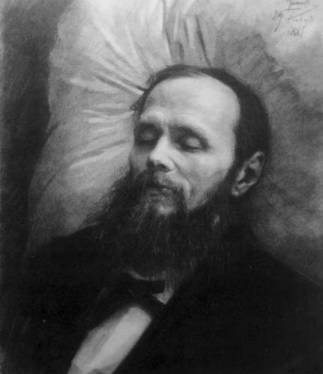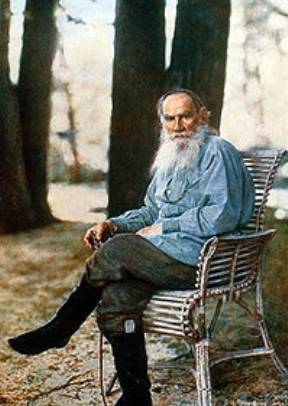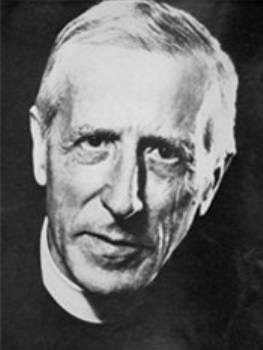
Fyodor Dostoevsky on his deathbed. 29 jan 1881

Lev Tolstoy. The colour foto.1908

Nikolay Fedorov, end of XIX. Painter Leonid Pasternak.

Pierre Teilhard de Chardin
The Self: what is it?
Soul arises together with body, after person death the soul holds in remembrance the genetic structure and lifelong history of the body. Thanks to this information the soul in the act of resurrection can completely restore its own unique material body, having opened all grandiose potentialities with which the body had been endowed by the God in the process of evolution.
1. Religious value of a physical body
2. The problem of identity of a body
3. Holy Fathers about unity of soul and body
4. Attempt of scientific approach
1. Religious value of a physical body
The doctrine about resurrection of dead seems absolutely alien to the spirit of contemporary Christianity which repeats these words by tradition, but already does not take them seriously. "Resurrection" is understood as a certain blissful postmortem condition in some thin, ethereal, in a word, not the genuine bodies.
As example, Fyodor Dostoevsky has been convinced that the present corporal organization of the man prevents to feel the “touch with the other worlds”. He presumed, for fulfillment of commandment about love to the neighbour, the person should “change himself physiologically” and consequently resurrection will be possible not earlier than “through 25 thousand years”. The body is considered as basic source of evil and vice. So, Lev Tolstoy was asserting with almost maniacal persistence: “the spirit is the good, the flesh is the evil”.
The negative attitude to the body follows from the false view that body is a source of morally condemned instincts – domination and submission, sexual lust, egoism and cruelty. From this false view the unfounded hope is born, that all these instincts itself "will disappear" together with "release" of soul from a body.
The deep mess of concepts takes place here, which has origin from the extremely defective, inadequate notion about a body. Actually the body as the most complicated, incredible rich and fine organized molecular-cellular structure, in general is out of sight of narrow-minded, unscientific consciousness. They usually perceive in a body only an insignificant part of its content: external forms and physiological functions.
The religious-mystical doctrines even this, as a rule, do not perceive: the concept of "body" (or, more often, of "flesh"), is identified with vital layers of psyche. That is, speaking about "body", they actually mean the lower part of soul: feeling, perceiving, instinctive.
Only thanks to achievements of a modern science: cytology, genetics, molecular biology – all the complexity, richness and beauty of internal structure of body has started to open and in this connection the feeling of religious delight in front of greatness of Divine Wisdom began to be born.
2. The problem of identity of a body
However, if to accept the Bible idea of corporal resurrection, a question emerges at once: where and how the vast information about a body of the died person is preserved, how the self-identity of a revived body may be ensured?
Great Russian philosopher Nikolay Fedorov tried to develop the idea about «collecting of all dispersed particles which were a part of the given body». This conception is amazing in its naivety and serves as a constant target for the ill-disposed criticism against Fedorov.
It is possible to agree with his hypothesis (by the way, entirely borrowed of St. Gregory of Nissa) that each molecule somehow preserves the remembrance about the body into which structure it was included. However it does not solve a problem because the body is not the sum of separate molecules, but the set of the structured molecular streams. During the life of man through his body the large quantity of molecules have flowed, many times more their number in a body at given moment. Besides, each molecule during the mankind existence has enough time to visit a plenty of various bodies – to which of them this molecule should belong after resurrection?
Realizing this difficulty, N. Fedorov in the end of his life has advanced to the idea about the collecting of "the primary elements of body”, which are dispersed in bodies of the living descendants of given person. It is possible to see in this idea the anticipation of modern doctrine about genes. However a new question emerges: whether self-identity of body does determined only by the set of genes? For example, the one-egg twins have absolutely identical genom, but certainly they have two different bodies!
Some of religious trends (in particular, the Jehovists) bring up such conception: the person completely disappears after death, and all information about him, which is necessary for his resurrection, is preserved only in God memory. But it would mean something like «Divine cloning»: in the act of resurrection not my father, but only his copy will emerge from hands of the Creator. Our filial feeling protests with all force against such substitution of the genuine father by his doublet. As well the problem can not be resolved by replacement of "Divine memory” with something like “a cosmic databank” or “the akasha-chronicle of the thin world”. The other person in other body will be restored after all.
We see the sole way for preservation of man self-identity: the uninterruption of his existence. While the death is not yet overcome, nothing but the human soul can ensure this continuity. Attracting the main attention to the physical body and its grandiose potentialities, we do not deny the existence of "the thin world” and of the multitude of spirits occupying this world. It is only the matter of the hierarchy of values. Contrary to the widespread opinion, we are deeply convinced, that for the Creator “the thin world”, as well as angelic hosts occupying it – is something preliminary, intermediate and auxiliary, whereas the highest value and the creation goal is namely the man. And in this we entirely follow the Bible.
Main distinction of the man from angels – his physical body, with all its richness and complexity. The Old Testament avoids to speak directly about the man soul (“soul is blood”). Idea of soul is unsafe for man: when the person starts to believe in its existence he begins at once to consider the body as something secondary and even negative. Quite often an image emerges of a body as "dungeons" from which the soul is being set free by means of death; thus the terrestrial person looks as some kind of “the captive angel”.
3. Holy Fathers about unity of soul and body
In connection with Bible idea of corporal resurrection it is necessary to rethink the notion not only about a body, but also about a soul. What is it - the soul? There are two variants usually offered: 1) the soul is “the spark of Deity”; 2) the soul had been created by God as separate essence and only later on it was enclosed or "installed" in a body. In both cases there is an inadmissible separation of soul from the body and their opposition each other.
Already St. Justin the Philosopher spoke about it:
“Who is the person, if not an animal reasonable, consisting of soul and body? Is the soul in itself the person? No, it isn't – it is a soul of the person. May the body be named the person? No, it isn't – it is called a body of the person … If the God has created the man for a life and resurrection He created not a part of man, but soul and body together”.
Following him Irenaes of Lyons insists on indissoluble ties of soul with a body:
“Soul does not exist before a body in its essence, neither body in his formation is not before a soul, but both occur simultaneously”.
Breaking off with Origen idea about «preexistence of souls», Gregory of Nissa states the key idea for our conception:
“Neither the soul occurs without body, nor body without soul, but one beginning at both. The person is not assembled from two parts, but in force of a birth he originates at once as soul and body. … The all is made at once, being hidden in the seed; as well the soul is in a seed, but is imperceptible … We recognize it is impossible that the soul would adapt to itself the other people's dwellings”.
St. Maximus the Confessor develops this thought in such formulation:
“The man never was unbodied … The man is not a soul, enclosed in a body, person is not assembled from soul and body. The soul arises and is born together with body”.
St. Gegory Palamas asserts, that the man by his nature (owing to the corporality) is similar to the God more, than angels:
“There is in our soul the part to dominate and rule and another – to submit and obey, namely: desire, aspiration, sensation and all another, standing below of mind, which the God has subordinated to the mind. And when we are guided by an inclination to a sin, we do not only revolt against the God - Pantocrator, but also against the autocrator (self-control) inherent to us by the nature. Owing to this beginning of the power in us the God has given us the rule over all the earth. Angels has not body connected with spirit and subordinated to spirit; therefore they do not rule, and only execute the will of God”.
4. Attempt of the scientific approach
Now we will try to express these deep ideas of holy fathers on a modern language of science. However it cannot be made without overcoming of a methodological precipice between sciences about a body and knowledges about a soul. Unprecedented intellectual break-through which was performed by a modern science in an explanation of the physical phenomena, allows us to expect, that the decision can be found through expansion of scientific concept of "the matter".
We assume the idea with best prospects is the concept of hidden primary matter of vacuum. The visible world represents set of certain states of exitement of this matter which is the general fundamental basis of both physical and the psychic phenomena. According to our hypothesis, the primary matter is structured as a crystal lattice of solid body. Today, thanks to opening of phenomena of superfluidity and superconductivity in solid bodies, the old objection against idea of "the space aether" can be removed. Thus it is possible to understand, why such incredibly dense “the crystal aether” does not render any resistance to usual physical bodies moving through this aether.
All the excitations of "vacuum crystal" are grouped in two basic classes which can be identified as physical and psychic matter. Communication between these two rather isolated types of a matter is so weak, that there is a huge area of the physical phenomena where influence of a psychic matter practically does not manifest itself. Only in this area the "exact sciences" are engaged.
Our next assumption: each excitation of physical type is inevitably accompanied by excitation of psychic type. Together with each physical atom always emerges the "psi-atom", and both atoms occupy approximately the same volume of space. Any physical body, including a live organism, generates «a psychic body», which repeats in general outline its nuclear structure. Using the notion "psyche" or "soul", we mean namely this psychic body.
The higher is an organism on evolution ladder (in process “zephalisation”, according to Teilhard de Shardin), the more independently and stable its psyche becomes, the stronger is its influence on physical body. On a certain level of development of the soul it starts to occupy the dominating position in relation to the body: the soul quite often forces the body to operate contrary to its own real requirements. For example, the healthy and reasonable soul counteracts the destructive processes in body – the ageing and illnesses; the sick and ignorant soul promotes these processes.
After the death of man his body gradually disintegrates (to say nothing about some exceptions, such as holy incorruptible relics) whereas the soul has independent existence for a while. The soul keeps information memory not only of all structures of the physical body, but also of all the processes which proceeded in this body from conception to death: the self-identity of the body is defined not only by its genetic structure, but also by all its vital history. It is this «soul memory» that creates possibility of the future reconstruction of body and restoration of integrity of the person - through reunion of soul with its own body.
We realize that similar notion about the person if to ponder this idea, can cause a certain ontological fear: if the soul is not created separately and is not an indestructible monad, in this case our existence becomes fragile, unreliable. And such experience is quite justified: we really are only on halfway from a non-existence to the genuine Being – process of our creation is not finished yet. A guarantee of my existence is not in me but in the God's design for me. It is only this design that gives absolute value to the person and ensures the unlimited prospect of his growth. Only our incompleteness allows to hope to achieve the deep structural, subconscious changes of the person according to the image of the God as the Trinity. The Good Message begins with a word “metanoia”: changing, alteration (Мt. 3:2), and all the Gospel, all New Testament is nothing other, as disclosing of sense of this word.


